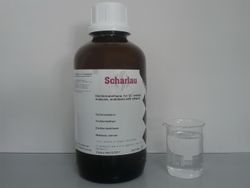Dichloromethane
 DCM sample and bottle.
| |
 DCM structure
| |
| Names | |
|---|---|
| IUPAC name
Dichloromethane
| |
| Systematic IUPAC name
Dichloromethane | |
| Other names
DCM, Di-clo, MDC, methylene chloride, methylenechloride, methylene dichloride, Narkotil, R-30, Refrigerant-30 Freon-30, Solaesthin, Solmethine, UN 1593
| |
| Identifiers | |
| Jmol-3D images | Image |
| |
| Properties | |
| CH2Cl2 | |
| Molar mass | 84.93 g/mol |
| Appearance | Colorless volatile liquid |
| Odor | Harsh, sweetish |
| Density | 1.3266 g/cm3 (20 °C) |
| Melting point | −96.7 °C (−142.1 °F; 176.5 K) |
| Boiling point | 39.6 °C (103.3 °F; 312.8 K) |
| 25.6 g/L (15 °C) 17.5 g/L (25 °C) 15.8 g/L (30 °C) 5.2 g/L (60 °C) | |
| Solubility | Miscible with acetone, benzene, carbon tetrachloride, chloroform, diethyl ether, ethanol, ethyl acetate, hexane |
| Vapor pressure | 0.13 kPa (−70.5 °C) 2 kPa (−40 °C) 19.3 kPa (0 °C) 57.3 kPa (25 °C) 79.99 kPa (35 °C) |
| Thermochemistry | |
| Std molar
entropy (S |
174.5 J·K−1·mol−1 |
| Std enthalpy of
formation (ΔfH |
-124.3 kJ·mol−1 |
| Hazards | |
| Safety data sheet | ScienceLab |
| Flash point | None, but can form flammable vapour-air mixtures above 100 °C |
| Lethal dose or concentration (LD, LC): | |
| LD50 (Median dose)
|
1.25 g/kg (rats, oral) 2 g/kg (rabbits, oral) |
| LC50 (Median concentration)
|
24,929 ppm (rat, 30 min) 14,400 ppm (mouse, 7 hr |
| Related compounds | |
| Related compounds
|
Chloromethane Chloroform Carbon tetrachloride |
| Except where otherwise noted, data are given for materials in their standard state (at 25 °C [77 °F], 100 kPa). | |
| Infobox references | |
Dichloromethane, also called methylene chloride and abbreviated DCM, is a liquid organic compound with the chemical formula CH2Cl2. It is a commonly used nonpolar laboratory solvent.
Contents
[hide]Properties
Chemical
Dichloromethane is not typically used as a reagent; its use focuses more on its physical properties, such as solvation properties and its low boiling point. It is significantly more stable than chloroform, a related solvent, and doesn't decompose unless heated upwards of 720 °C, and this yields carbon dioxide and hydrogen chloride rather than the deadly phosgene.
Physical
Dichloromethane is a clear liquid with low viscosity at room temperature and has a high index of refraction (1.4244) giving it a shiny appearance. It has a sweet smell similar to that of chloroform. Dichloromethane is quite volatile, and boils at only 39.6 °C (103.3 °F), not far above human body temperature. It is not miscible in water. DCM's main use in the laboratory is as a nonpolar solvent, and is particularly associated with the extraction of alkaloids such as caffeine, as well as other plant extracts. It readily dissolves many plastics, including polyethylene, nitrile, and polyurethane and is best stored in glass containers with PTFE or polypropylene (PP) lids.
From an amateur chemistry perspective, dichloromethane is a very good solvent for removing label glue in order to repurpose various containers for reagent storage.
Availability
Dichloromethane, being a popular solvent, can be purchased at hardware stores and body shops as a solvent, paint thinner, or degreaser. While some brands do contain nearly pure DCM, many more contain dichloromethane along with some other solvents; these may or may not be easily purified by distillation. It is very difficult to obtain in the European Union, sadly, since its ban as a degreaser and paint thinner for consumers and even for many professionals.
In countries where DCM isn't available, a very similar substitute, 1,2-Dichloroethane, can often be found. It can be used for most of the same purposes.
Preparation
While dichloromethane is usually far easier to purchase than produce, it can be formed, along with all of the other chloromethanes, by combination of methane and chlorine gas at high temperatures. This process can also be done to produce more highly chlorinated chloromethanes from lower ones, meaning chloromethane (methyl chloride) can be chlorinated to produce dichloromethane, trichloromethane, and carbon tetrachloride. None of these processes, however, are easy or economical to perform in a home lab.
DCM can also be prepared by reducing chloroform with hydrochloric acid and zinc metal in ethanol.
- CHCl3 + Zn + 2 HCl → CH2Cl2 + ZnCl2 + HCl
If the pH of the solution is neutral, then methane will be formed, and not DCM.
- CHCl3 + Zn + H2O → CH4 + ZnCl2 + HCl[1]
Projects
- Extract caffeine from tea or coffee
- Separate organic compounds from salts
Handling
Safety
Like many organochlorine compounds, dichloromethane shows carcinogenic properties in lab tests. Though it is the least toxic of the chlorinated methane compounds, upon ingestion, it is metabolized to carbon monoxide, a very potent toxicant, making it dangerous nonetheless to swallow.
Unlike chloroform, dichloromethane does not produce phosgene.
Storage
DCM should be stored in dark glass bottles, away from light or any heat sources. The botthe should be open from time to time, to release the pressure, especially if the temperature starts to rise in the storage place, usually during summer.
Disposal
DCM can neutralized with an alkaline solution or by slowly dropping it in Fenton's reagent. Do this outside, as some DCM will evaporate.
See also
- Chloromethane/methyl chloride
- Chloroform (trichloromethane)
- Carbon tetrachloride
References
- Jump up ↑ Organic Chemistry, RL Madan, Tata McGraw-Hill Education, pag. 379
Relevant Sciencemadness threads
- Chemical pages without CAS Registry Number
- Articles without EBI source
- Chemical pages without ChemSpiderID
- Chemical pages without DrugBank identifier
- Articles without KEGG source
- Articles without InChI source
- Articles without UNII source
- Articles containing unverified chemical infoboxes
- Chemical compounds
- Organic compounds
- Organochlorine compounds
- Haloalkanes
- Solvents
- Nonpolar solvents
- Readily available chemicals
- Carcinogenic
- Volatile chemicals
- Liquids
- Irritants